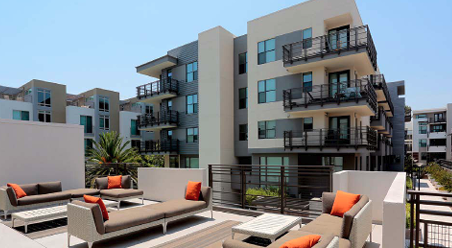Perhaps the most salient information within Lee & Associates’ 2024 Q3 North America Market Report pertains to the office market. The third quarter of 2024 ended nine continuous quarters of negative net absorption in the office sector. However, additional occupancy losses may be on the horizon for the office market, even as supply pressures ease for this property type.
Positive retail news has led to positive industrial news, as rising demand for retail goods has bolstered tenant demand for industrial space just as additional industrial inventory is coming on line.
Steady economic growth and continuing impediments to home ownership have created strong absorption in the multifamily sector. Rent growth and vacancy rates have largely plateaued.
Lee & Associates has made their complete third-quarter report available here (with more detailed information broken down according to property type). Below is an overview of the strengths and challenges in the industrial, office, retail and multifamily sectors.

Industrial Overview: U.S. Demand Spikes
Industrial demand across the United States dramatically improved in the third quarter. There were 52.8 million square feet of positive net absorption in the country in the third quarter, a 76 percent jump from the same period a year ago and more than double the 23.9 million square feet of growth in the first half.
Overall real retail goods spending, which has been driving the new leasing, has risen gradually since early 2023 as inflation subsides. According to the latest data, inflation-adjusted spending rose 5.3 percent over the prior year in July, the fifth consecutive month of growth greater than 5 percent. The pickup was led by sales at non-store retailers and general merchandise stores.
There are other signs that a steady recovery in tenant demand is underway. Declines in warehousing jobs, which persisted throughout 2023, have leveled off in recent months. Monthly U.S. imports, which also declined last year, have been rising at double-digit year-over-year rates since February. These gains are accommodated by larger volumes of goods flowing through the U.S. distribution network.
The strong tenant demand was well timed. A surge in new development since 2022 represents the fastest pace of supply growth in more than three decades. Inventory grew by 2.2 percent in 2022 and 2.9 percent in 2023. The fourth quarter’s 200 million square feet of added inventory was a quarterly record. The volume of completions will remain elevated through 2024 or early 2025 when deliveries fall off as increased interest rates slowed groundbreakings to a 10-year low.
In line with these improvements, the square footage of new U.S. industrial leases signed during the second quarter of 2024 was up about 10 to 15 percent compared to the second quarter of 2023 when adjusting for the typical lag at which deals are uncovered. Year-over-year gains have continued in the first several weeks of the third quarter. Following some of the best months on record for operating profits of its North American division, Amazon, America’s largest industrial tenant, has reaccelerated its distribution center network expansion.
In its recent string of lease signings, for example — totaling more than 1 million square feet in markets including the Inland Empire, Phoenix and Stockton, California — the e-commerce giant has already signed more new leases so far in 2024 than it did during all of 2023.
While new deliveries have peaked, several sunbelt and Midwest markets with fewer constraints on new development are still in the midst of a record supply wave that could take tenants more than two years to fully absorb.
Austin, Indianapolis, Greenville/Spartanburg, Phoenix and San Antonio stand out as markets with risks of prolonged higher availability rates, particularly among larger industrial properties as developers have been focused on building projects 50,000 square feet or larger in recent years.
Office Overview: U.S. Net Absorption Turns Positive
Office demand in the United States turned positive in the third quarter, ending a streak of nine straight quarters of negative net absorption. While growth remained weak, the uptick is due to increases in owner occupancy and medical office users along with fewer large move-outs. Third-quarter net growth in the U.S. totaled 7.6 million square feet but year-to-date net absorption remains 20.8 million square feet in the red.
Sources tracking U.S. office usage indicate that average office attendance is roughly at 70 percent of its 2019 level and is trending about five to 10 percentage points more than a year ago. While attendance clearly is rising to some degree, year-over-year job growth in office-using sectors has stalled, rising at less than 1 percent since mid-2023.
New leasing volume has hovered around 10 percent less than the average from 2015 to 2019. Much of the decline has been driven by average lease sizes that are some 15 to 20 percent less than the 2015 to 2019 average.
Currently 193 million square feet is available for sublease, more than half of which lies vacant. This is down meaningfully since mid-2023, when it was more than twice what it was at the end of 2019. Moreover, the surge in sublease inventory, which still is nearly double pre-COVID levels, has likely brought forward some of the expected impact connected with future lease expirations.
A substantial amount of leased space has not yet rolled over, so the full force of post-pandemic-occupancy strategies has yet to filter through the market. Most of this should occur in the next two to three years, resulting in additional occupancy losses that could exceed 80 million square feet.
The one bright spot in the outlook is that supply pressure is easing. The 82.7 million square feet underway is the least since 2013 and the 20 million square feet in starts in the past year is the lowest on record.
Asking rents are expected to dip as basis resets and the glut of second-hand space availability comes to bear. This is well underway in some tech-focused areas like San Francisco, Seattle and San Jose, where sales at much lower valuations have given others more flexibility to reduce asking rents.
Markets such as Houston and Miami appear reasonably healthy, while others, including New York, may be near the bottom in the occupancy market. Cooling inflation and steady economic growth mean that the hoped-for “soft landing” scenario is more likely, bringing the prospect of lower interest rates that could ease distress for some owners and lenders.
Throughout the U.S., demand and market conditions favor the newest top-tier buildings. Demand in suburban and secondary markets is also faring comparatively better than in the past.

Retail Overview: Strong Growth Across North America
Nation-wide retail property markets could scarcely be healthier. U.S. retail real estate heads into the second half of 2024 in one of its tightest fundamental positions on record thanks to steadily rising demand, a reduction in tenant bankruptcies and store closures and limited new supply.
Tenant demand for U.S. retail space totaled 6.6 million square feet in the third quarter. The positive net absorption is driven by expansion in numerous sectors with the most significant gains from tenants in the food and beverage, discount, off-price, and experiential sectors. These accounted for over half of all new leasing activity over the past year.
Only 4.7 percent of retail space is currently available for lease. Retail availabilities have been hovering around historic lows since the end of 2022 and are now more than 200 basis points less than the historical average of 6.8 percent. Availabilities have been contracting across nearly every retail subtype over the past year, with only the freestanding segment seeing availability rise during that time.
While demand for space continues to rise, new retail development activity remains minimal. Net deliveries totaled just 33.7 million square feet over the past 12 months, which is less than half of the prior 10-year average.
From a geographic perspective, the most significant uptick in demand for retail space has been seen in Sun Belt markets that are experiencing substantial population and buying power growth. Seven of the top 10 markets leading the way in inventory-adjusted demand growth over the past year were in the Sun Belt, including four of the top five (Austin, Orlando, Miami and Phoenix). The other three markets in the top 10 for inventory-adjusted demand growth over the past year were all in the Midwest, with Indianapolis, Saint Louis, and Minneapolis each seeing absorption of at least 1.5 million square feet over that time.
Although slowing since the first quarter, retail asking rents continue to rise at an above-average pace. Asking rents for retail spaces have increased by 2.3 percent over the past year to a record high of $25 per square foot.

Multifamily Overview: Strong Demand Defines Sector
There was strong tenant demand for apartments across North America in the third quarter, with record-level net absorption in the United States.
Third-quarter net absorption totaled 180,461 apartments in the U.S. and 468,096 units year to date for the second most on record. It was exceeded only by the 621,680 units driven by COVID in the first three quarters of 2021. The current healthy demand was driven by stable economic growth, plus a continued slowing of renter households making the jump to ownership and creating fewer units to backfill.
And while U.S. supply additions have outpaced demand over the past 11 quarters, the gap has closed significantly. In the second quarter, the supply/ demand gap only totaled 15,000 units, which held the vacancy rate steady at 7.8 percent. This is the first time vacancy has remained unchanged for almost three years.
Additionally, overall rent growth appears to have stabilized and may have hit an inflection point. Rent growth has held steady in the 1.0 percent range over the past four quarters with premium properties posting the lowest gains.
The Class A segment imbalance has pushed up vacancy rates across the Sun Belt. For instance, in Austin, Texas, the overall vacancy rate climbed from 10.4 percent in the second quarter of 2023 to 14.1 percent with the vacancy rate for premium properties surging by 440 basis points to 15.5 percent. Similarly, in San Antonio, the Class A vacancy rate rose 200 basis points from the second quarter of 2023 to the second quarter of 2024, contributing to an increase in the market’s overall vacancy from 11.3 to 12.8 percent.
Nevertheless, not all markets experienced an increase in vacancy rates over the past year. Vacancy rates declined in five markets—Baltimore, East Bay, Pittsburgh, Richmond, and San Francisco—as net absorption outpaced supply additions. All five markets were at or below the national 7.8 percent vacancy rate at the end of the second quarter, with Pittsburgh at 5.9 percent, San Francisco at 6.2 percent, East Bay at 6.8 percent, Baltimore at 7 percent and Richmond, the highest among the five, at 7.8 percent.
— Lee & Associates Research Department. Lee & Associates is a content partner of REBusinessOnline. To read all of the 2024 Q3 North America Market Report, click here.
Office photo by Israel Andrade on Unsplash.


